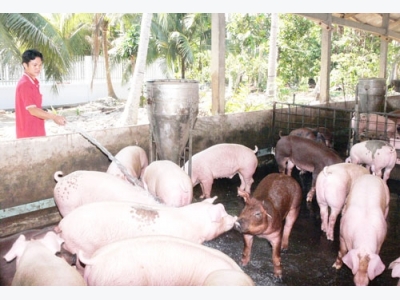Ministry wants enterprises to share hardships with pig farmers

HANOI - As the price of live pigs is currently below production cost and market uncertainties overshadow the sector, the Ministry of Agriculture and Rural Development has required enterprises in the industry to share difficulties with farmers.
Oversupply
Live pig prices have fallen dramatically, sometimes to only VND25,000 per kilo. The main reason is that domestic production has far exceeded demand, said Minister of Agriculture and Rural Development Nguyen Xuan Cuong at a conference on solutions for livestock industry stabilization and development on April 24.
Twenty years ago, pork made up 60% of a family’s protein food sources. Now, the proportions of other products such as beef, goat meat, eggs and milk have gradually increased, piling huge pressure on the pig farming industry.
The livestock sector is not well organized as more than 55% of farms belong to households, numbering three million. This leads to high costs. Therefore, when market conditions turn sour, small-scale farming households are the first to take a hit.
Processing is one of the weakest links in the chain. Except some deep-processing enterprises with cold storage facilities, a majority of pork output is sold immediately after pigs are slaughtered.
The modern distribution network is not widespread. The export volume is not high, and pork has not yet been sold in the formal way to other countries in the region.
Vo Viet Dung, director of Anh Dung Investment, Trading and Production Co, said: “Vietnam’s pig price is now the lowest in the world.” In Ngoc Lu (Ha Nam), the price of pigs has declined to about VND1.5 million a pig of 140-150 kg, yet there are still no buyers.
To save the livestock industry, an immediate solution is to bring down the price of inputs such as bran, breeds, veterinary drugs and other related products, Cuong suggested. “At this point, input suppliers must sympathize with farmers. This is a way to nourish the market in times of hardship.”
In addition, businesses are encouraged to invest in processing and storage, and focus on purchasing, processing and stockpiling a portion of surplus pork output.
In addition, the Department for Animal Health should focus on safety solutions because if pork prices continue to go down, farmers will neglect vaccination due to heavy losses, which may result in disease outbreaks.
Restructuring
In the long run, the most fundamental solution is to quickly restructure the livestock industry, first with a reduction in sows, particularly from 4.2 million to three million in 2019, said Cuong.
Besides, this sector should be reorganized in the form of concentrated farming. The three million small-scale farming households should join associations or cooperatives or form small businesses.
Some households should switch to raising buffaloes, cows or goats.
As for enterprises, the minister encouraged them to step up deep processing and diversify products. Export markets should be expanded in line with domestic chain development.
At the conference, Le Ba Lich, chairman of the Vietnam Animal Feed Association, said his association would call on all animal feed producers to cut prices and share difficulties with farmers. “If livestock farmers go bust, feed mills would be just scrap heaps,” he said.
He suggested the agriculture ministry promote the signing of animal health agreements with meat importing countries to look for outlets for domestic meats.
Meanwhile, Pham Van Hoc, vice chairman of Dabaco Vietnam Group, proposed the ministry build a warning system about market demand for farmers and enterprises. In addition, a pause in meat import to give back the market to domestically-made products should be considered.
Related news
 Vietnamese robusta coffee prices fall to four-month low, trade at standstill
Vietnamese robusta coffee prices fall to four-month low, trade at standstill This slump follows the country's coffee exports in the first half of the 2016/2017 season hitting a three-year high.
 Vegetable exports reach nearly 190 billion vnd per day
Vegetable exports reach nearly 190 billion vnd per day Vegetable exports continue to be an impressive bright spot in the export activities of the first two months of 2017 in Vietnam with a high growth of double
 Vietnam spends US$338 million on fertilizer imports in Q1
Vietnam spends US$338 million on fertilizer imports in Q1 Vietnam’s fertilizer imports soared in the first quarter of 2017 after a sharp decrease in 2016, reaching 1.22 million tons worth US$338 million